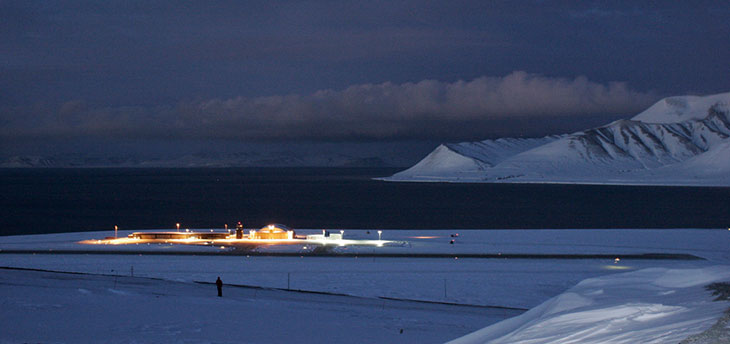Weird Arctic Weather Causes Near-Disaster In Northernmost Town
(Inside Science) -- What happens when it gets too warm in the dead of an Arctic winter? As residents of Norway's northern islands found out in January 2012, it could become a disaster.
The snow and ice on the islands melted. It rained for days and the high temperatures lasted for two weeks. Permafrost, the frozen soil that can reach hundreds of feet deep, started to melt. Then it got cold again and everything froze over. Snow collected in potentially deadly avalanches. The remote islands were cut off from the European mainland. Wildlife died.
Although Norwegian scientists believe this was a once-in-500-year event, climate change may bring more winters like the winter of 2012, and it is happening elsewhere.
In a paper published in Environmental Research Letters, the scientists said the only good news is that it could actually have been worse.
Nonetheless, "The frequency of warm spells and heavy rain-on-snow events in the Arctic is increasing and is expected to increase further during the 21st century," they wrote.
The research was unique both for how extreme the weather event was, and the fact scientists from multiple disciplines could study it, according to Brage Bremset Hansen, from the Center for Biodiversity Dynamics at the Norwegian University of Science and Technology in Trondheim, a lead author.
"It was an extreme event," he said. Being above the Arctic Circle, it all happened in the coal-dark of night.
The scene of the weather anomaly was the Norwegian archipelago -- or group of islands -- of Svalbard (once called Spitzbergen) and the town of Longyearbyen, the world's northernmost town. The winter population is 2,040. The islands have seen the greatest increase in temperature of anywhere in Europe in the last 30 years.
The weather event occurred from Jan. 26 to Feb. 9, 2012 A long-lasting high-pressure system over northern Scandinavia pushed several low-pressure systems with warm moist air over northern Norway. Temperatures rose above freezing all over the area.
Normally, winter in Longyearbyen means temperature hovering around zero Fahrenheit. But that January, it climbed to 46 in one place. Snow and ice began to melt. The snow in the mountains became so saturated the wet, heavy snow caused slush avalanches. No one was killed or injured although the potential danger was real. In 1953, an avalanche destroyed the town hospital and killed three people, they reported.
The 2012 avalanche blocked a pedestrian bridge.
The rains were historic. On Jan. 30, four inches of rain fell on the little town of Ny-Ålesund (population 30), one-quarter of its normal yearly precipitation.
The effects on the permafrost, which normally freeze the soil up to 650 to 1500 feet deep, were extreme. Permafrost is ubiquitous in the Arctic and continuous in Svalbard, according to Ketil Isaksen of the Norwegian Meteorological Institute, one of the researchers. From the middle of the 19th century until 1900, the permafrost temperature increased about 1.8 degrees Fahrenheit (one degree Celsius). It has warmed almost that much again since 1900. The warming temperatures reached as deep as 15 feet. This added to the melting already recorded in the last 10 years, Isaksen said.
Then, the region abruptly froze again. Temperatures plunged into the teens or lower. Streets were covered with sheets of ice. Snowmobiles could not get traction. In some places, the ice was six inches thick. The tundra surrounding the settlements was particularly affected.
"There is no forest in Svalbard, only tundra," in which the soil below the surface is frozen, said Hansen. "The tallest plants (except for some grasses) are a couple of inches tall. This includes dwarf shrubs."
Reindeer (domesticated caribou) who feed on the plants, suffered the most. The rain falling on the snow percolated to the base of the snowpack, pooled and then froze, making it impossible for the reindeer to find food. Hansen found an almost-record number of reindeer carcasses on the tundra. They had starved to death.
Fortunately for the reindeer, they had enjoyed a good summer so there was better foraging before the incident, Hansen said. Otherwise, it would have been worse.
Planes were grounded and the airport closed. Since air is the only viable means of transportation in the winter, it meant the archipelago was cut off. Tourists disappeared.
Isaksen said global warming is likely to make winters like this more common.
Similar events, although less radical, are occurring all over the Arctic.
In interior Alaska, schoolchildren had no concept of snow days until about five years ago, when schools were closed because driving was too hazardous or impossible. Now, they have rain days, because rainwater has nowhere to go in towns like Fairbanks, and the water freezes as temperatures return to normal, said Rick Thoman, Climate Sciences and Service Manager for the National Weather Service, Alaska Region.
"Last year rain in November produced sheets of ice on secondary roads that lasted until April," he said.
"In Fairbanks, we have had a spate of winter rain events in the last 10 years or so and it got to the point where highway folks are doing different things than in the past—deicing roads," Thoman said. Rain records are being set.
The Norwegian scientists believe that while history shows this is a rare event on the northern islands, it may be part of a new trend, and with climate change, people who live in the far North may have to learn to cope.


